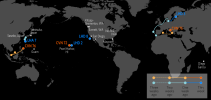The long-awaited US CHIPS Act has finally been
signed into law by President Biden, unlocking $52 billion in funding to boost the American semiconductor industry as a part of the broader $280 billion CHIPS and Science Act. Now the industry has to make good on its promises in a market where inflation is rapidly stifling demand.
Behind all the words about driving innovation and creating jobs, the chief reason behind the CHIPS Act is a fear that the US will be overtaken by rivals such as China in the semiconductor industry, which is believed to be in the process of investing well over $150 billion by 2030 in trying to promote its own homegrown chip companies. In the face of this, America is playing catch-up.
This fear is not misplaced because the high-tech semiconductor industry plays a vital part in the global economy, and will only become more important as IT and computers play a bigger role in almost everything. Yet according to the
National Institute of Standards and Technology (NIST), the US accounted for just 11 percent of global semiconductor fabrication capacity in 2019, down from around 40 percent in 1990.
The CHIPS Act thus seeks to restore US leadership in semiconductor manufacturing by "providing incentives and encouraging investment to expand the domestic manufacturing capacity necessary to produce the most advanced semiconductors," according to NIST. These will be needed to drive applications in AI and high-performance computing, but there is also a need for other less advanced chips that are found in automobiles and domestic appliances as well.
This touches on another reason for investing in semiconductor manufacturing – the supply chain problems that have hit industries such as automotive manufacturing over the past year or two, resulting in customers waiting months for new vehicles or production being cut because of a shortage of the chips that automobiles are packed with these days.
However, any new investment coming into semiconductor plants now will not bear fruit for several years, simply because it takes this long to build them and ramp up production. Construction work
started in July on Intel's planned mega-fab site in Ohio, for example, and these semiconductor manufacturing plants are not expected to start producing chips until 2025.
Meanwhile, much of the shortage of chips for industries such as automobile makers has been the result of limited investment in mature process technologies, such as those at 40nm and above, which are used for cost-effective production of various low-tech components, as
research company IDC pointed out earlier this year.
According to Bloomberg, lead times for some components have reduced only slightly, from 27 weeks in June to an average 26.9 weeks in July, with the supply of power management chips and microcontrollers particularly affected, and these are components that a great many products require in order to function.
But the semiconductor industry is now bracing itself for a fall-off in demand as a result of inflationary pressures being felt in economies around the world.










